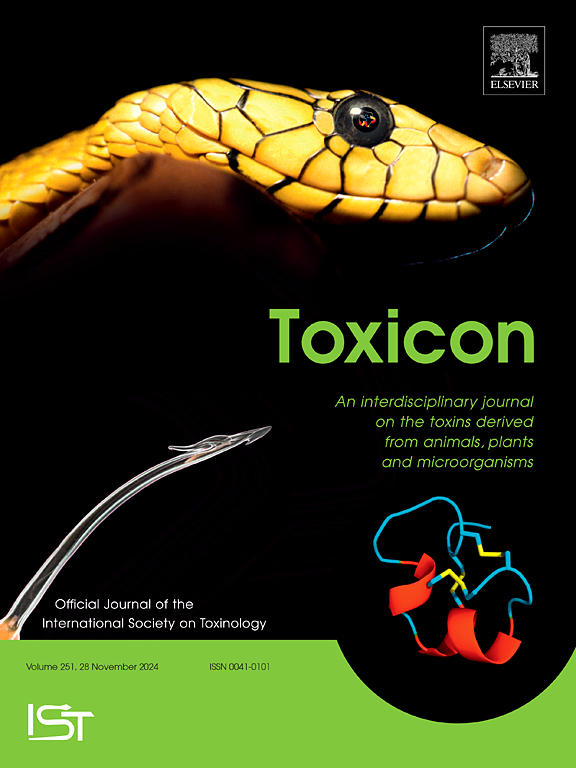Hepatoprotective effects of dandelion against AFB1-induced liver injury are associated with activation of bile acid-FXR signaling in chicks
IF 2.6
4区 医学
Q2 PHARMACOLOGY & PHARMACY
引用次数: 0
Abstract
This study aimed to investigate the protective effects of dandelion against AFB1-induced hepatotoxicity through the regulation of the FXR signaling pathway in chicks. A total of 144 one-day-old male broilers were randomly assigned to three groups and received a basal diet (BD), and BD supplemented with 0.5 mg/kg of AFB1 or 0.5 mg/kg AFB1 with 0.4 % dandelion for 3 weeks. The results showed that the AFB1 treatment caused liver injury and decreased the concentrations of albumin and alkaline phosphatase in serum and increased the total bile acid concentration in serum and liver. Dietary AFB1 supplementation also induced hepatocyte swelling, necrosis, neutrophils infiltration and lipid deposition in the liver. Notably, dietary dandelion supplementation alleviated these alterations induced by AFB1. Additionally, dietary dandelion supplementation alleviated AFB1-induced changes in ileum microbiota and decreased the abundance of Lactobacillus, L. vaginalis, and L. acidophilus compared to the AFB1 treatment. Furthermore, AFB1 downregulated Baat, Ntcp, Acc, FXR, SHP, and SREBP-1c expression, and upregulated Cyp8b1, Bacs, Fas, Pparα, Lxrα and CYP7A1 expression in liver. Meanwhile, AFB1 also downregulated Fgf19, Ostα, Ostβ and FXR expression and upregulated SHP expression in the ileum. Conclusively, dietary dandelion supplementation protected broilers from AFB1-induced hepatotoxicity, potentially due to the activation of bile acid-FXR signaling pathway.
蒲公英对afb1诱导的雏鸡肝损伤的保护作用与激活胆汁酸- fxr信号有关。
本研究旨在探讨蒲公英通过调控雏鸡FXR信号通路对afb1诱导的肝毒性的保护作用。试验选用144只1日龄肉鸡,随机分为3组,分别饲喂基础饲粮(BD)和在基础饲粮中添加0.5 mg/kg AFB1或0.5 mg/kg AFB1中添加0.4%蒲公英,试验持续3周。结果表明,AFB1处理引起大鼠肝损伤,血清白蛋白和碱性磷酸酶浓度降低,血清和肝脏总胆汁酸浓度升高。饲粮中添加AFB1还会引起肝细胞肿胀、坏死、中性粒细胞浸润和肝脏脂质沉积。值得注意的是,饲粮中添加蒲公英可减轻AFB1诱导的这些改变。此外,与AFB1处理相比,饲粮中添加蒲公英减轻了AFB1诱导的回肠微生物群变化,降低了乳酸菌、阴道乳杆菌和嗜酸乳杆菌的丰度。此外,AFB1下调肝脏Baat、Ntcp、Acc、FXR、SHP和SREBP-1c的表达,上调Cyp8b1、Bacs、Fas、Pparα、Lxrα和CYP7A1的表达。同时,AFB1下调回肠中Fgf19、Ostα、Ostβ和FXR的表达,上调SHP的表达。总之,饲粮中添加蒲公英可以保护肉仔鸡免受afb1诱导的肝毒性,可能是由于激活了胆汁酸- fxr信号通路。
本文章由计算机程序翻译,如有差异,请以英文原文为准。
求助全文
约1分钟内获得全文
求助全文
来源期刊

Toxicon
医学-毒理学
CiteScore
4.80
自引率
10.70%
发文量
358
审稿时长
68 days
期刊介绍:
Toxicon has an open access mirror Toxicon: X, sharing the same aims and scope, editorial team, submission system and rigorous peer review. An introductory offer Toxicon: X - full waiver of the Open Access fee.
Toxicon''s "aims and scope" are to publish:
-articles containing the results of original research on problems related to toxins derived from animals, plants and microorganisms
-papers on novel findings related to the chemical, pharmacological, toxicological, and immunological properties of natural toxins
-molecular biological studies of toxins and other genes from poisonous and venomous organisms that advance understanding of the role or function of toxins
-clinical observations on poisoning and envenoming where a new therapeutic principle has been proposed or a decidedly superior clinical result has been obtained.
-material on the use of toxins as tools in studying biological processes and material on subjects related to venom and antivenom problems.
-articles on the translational application of toxins, for example as drugs and insecticides
-epidemiological studies on envenoming or poisoning, so long as they highlight a previously unrecognised medical problem or provide insight into the prevention or medical treatment of envenoming or poisoning. Retrospective surveys of hospital records, especially those lacking species identification, will not be considered for publication. Properly designed prospective community-based surveys are strongly encouraged.
-articles describing well-known activities of venoms, such as antibacterial, anticancer, and analgesic activities of arachnid venoms, without any attempt to define the mechanism of action or purify the active component, will not be considered for publication in Toxicon.
-review articles on problems related to toxinology.
To encourage the exchange of ideas, sections of the journal may be devoted to Short Communications, Letters to the Editor and activities of the affiliated societies.
 求助内容:
求助内容: 应助结果提醒方式:
应助结果提醒方式:


